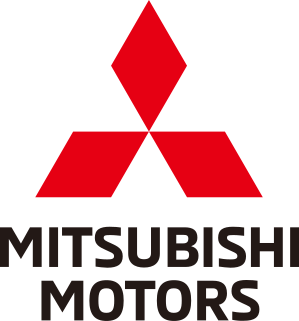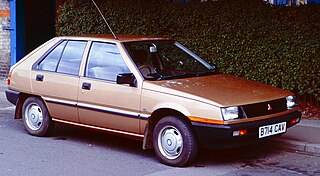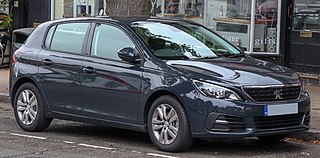The Mitsubishi SUW (Smart Utility Wagon) is a series of concept cars sharing a common design theme, and first exhibited by Japanese automaker Mitsubishi Motors at the 1999 Frankfurt and Tokyo Motor Shows. [1] [2]

A concept car is a car made to showcase new styling and/or new technology. They are often shown at motor shows to gauge customer reaction to new and radical designs which may or may not be mass-produced. General Motors designer Harley Earl is generally credited with inventing the concept car, and did much to popularize it through its traveling Motorama shows of the 1950s.

Japan is an island country in East Asia. Located in the Pacific Ocean, it lies off the eastern coast of the Asian continent and stretches from the Sea of Okhotsk in the north to the East China Sea and the Philippine Sea in the south.

Mitsubishi Motors Corporation is a Japanese multinational automotive manufacturer headquartered in Minato, Tokyo, Japan. In 2011, Mitsubishi Motors was the sixth-biggest Japanese automaker and the nineteenth-biggest worldwide by production. From October 2016 onwards, Mitsubishi has been one-third (34%) owned by Nissan, and thus a part of the Renault–Nissan–Mitsubishi Alliance.
The Smart Utility Wagon theme was introduced late in 1998 as a demonstration of the company's corporate slogan of the time, "Innovation in Motion", which was itself to represent "smart design" and "ecology conscious[ness]". Specifically, SUWs shared the company's gasoline direct injection (GDI) engine technology, a taller roofline for easier entry and exit, and interior space competitive with larger vehicles. [3] The three individual vehicles Mitsubishi produced were the SUW Advance, a five-door hatchback family car, the SUW Compact a three-door hatchback small car, and the SUW Active sport utility vehicle. [2]

Gasoline direct injection (GDI), is a form of fuel injection employed in modern two-stroke and four-stroke gasoline engines. The gasoline is highly pressurized, and injected via a common rail fuel line directly into the combustion chamber of each cylinder, as opposed to conventional multipoint fuel injection that injects fuel into the intake tract or cylinder port. Directly injecting fuel into the combustion chamber requires high-pressure injection, whereas low pressure is used injecting into the intake tract or cylinder port.

A hatchback is a car with a hatch-type rear door that opens upwards and often a shared volume for the passenger and cargo areas.

Sport utility vehicle (SUV) is a category of motor vehicles which combine elements of road-going passenger cars with features from off-road vehicles, such as raised ground clearance and four-wheel drive.

The Volkswagen XL1 is a two-person limited production diesel-powered plug-in hybrid produced by Volkswagen. The XL1 car was designed to be able to travel 100 km on 1 litre of diesel fuel, while being both roadworthy and practical. To achieve such economy, it is produced with lightweight materials, a streamlined body and an engine and transmission designed and tuned for economy. The concept car was modified first in 2009 as the L1 and again in 2011 as the XL1.

The Nissan Sunny is an automobile built by the Japanese automaker Nissan from 1966 to 2006. In the early 1980s, the brand changed from Datsun to Nissan in line with other models by the company. Although production of the Sunny in Japan ended in 2006, the name remains in use in the Chinese market for a rebadged version of the Nissan Latio.

The Hyundai Elantra, or Hyundai Avante in South Korea, is a compact car produced by the South Korean manufacturer Hyundai since 1990.

The Mitsubishi Mirage is a range of cars produced by the Japanese manufacturer Mitsubishi from 1978 to 2003 and again since 2012. The hatchback models produced between 1978 and 2003 were classified as subcompact cars, while the sedan and station wagon models, marketed prominently as the Mitsubishi Lancer, were the compact offerings. The liftback introduced in 1988 complemented the sedan as an additional compact offering, and the coupé of 1991 fitted in with the subcompact range. The current Mirage model is a subcompact hatchback and sedan and it replaces the Mitsubishi Colt sold between 2002 and 2012.

The Kia Rio is a subcompact car produced by the South Korean manufacturer Kia since November 1999 and now in its fourth generation. Body styles have included a three and five-door hatchback and four-door sedan, equipped with inline-four gasoline and diesel engines, and front-wheel drive.

The Hyundai Theta (G4KC) is a gasoline four-cylinder automobile engine family. The third all-aluminum engine of Hyundai Motor Company debuted in the fourth-generation Hyundai Sonata sedan, which was unveiled in August 2004 in South Korea. Hyundai Motor Manufacturing Alabama (HMMA) built a Theta II engine shop on the grounds of their Montgomery, Alabama automobile factory.

The Chevrolet Sail is a supermini car produced by the Chinese manufacturer Shanghai General Motors. Launched in 2001, it was sold as the Buick Sail, both in sedan and wagon form which were both based on Opel Corsa B. Since 2005, as the brand Chevrolet was officially introduced in China, the car received a facelift and its name was changed to Chevrolet Sail and Sail SRV.
Shell Eco-marathon is a world-wide energy efficiency competition sponsored by Shell. Participants build automotive vehicles to achieve the highest possible fuel efficiency. There are two vehicle classes within Shell Eco-marathon: Prototype and UrbanConcept. There are three energy categories within Shell Eco-marathon: battery-electric, hydrogen fuel cell, and internal combustion engine. Prizes are awarded separately for each vehicle class and energy category. The pinnacle of the competition is the Shell Eco-marathon Drivers' World Championship, where the most energy efficient UrbanConcept vehicles compete in a race with a limited amount of energy.

The Eagle Medallion, also marketed as the Renault Medallion, was a rebadged and mildly re-engineered North American version of the French Renault 21 marketed by Eagle.

The Peugeot 308 is a small family car produced by the French car manufacturer Peugeot. It was unveiled on 5 June 2007, and launched in September 2007. Its development code was "Project T7", and is the first car of the X08 generation of Peugeot models. The 308 features a range of petrol and diesel engine options. In March 2011, the 308 received a facelift, and it premiered at the Geneva Motor Show.

The Mitsubishi 4A3 engine is a range of alloy-headed inline four-cylinder engines from Mitsubishi Motors, introduced in 1993 in the sixth generation of their Mitsubishi Minica kei car.

The Mitsubishi 3B2 engine is a family of all-alloy three cylinder engines developed by Mitsubishi Motors, first produced in December 2005 at the company's Mizushima powertrain facility in Kurashiki, Okayama, for introduction in their 2006 Mitsubishi i kei car. All engines developed within this family have aluminum cylinder block and head, double overhead camshafts, four valves per cylinder, and MIVEC continuous variable valve timing.

The Mitsubishi Pistachio is a three-door hatchback introduced by Mitsubishi Motors in December 1999, based on the platform of their Minica kei car. Only 50 Pistachios were sold in either Citron Yellow and Loire Green colour schemes, priced at ¥959,000, to local authorities and public corporations working to protect the environment.

The Mitsubishi RVR is a range of cars produced by Japanese manufacturer Mitsubishi from 1991 to 2002 and from 2010 to present. The first two generations were classified as compact multi-purpose vehicles (MPV), whereas the model introduced in 2010 is a subcompact crossover SUV.

The Hyundai i30 is a small family car manufactured by the South Korean manufacturer Hyundai in Nošovice, Czech Republic, since 2007. The i30 shares its platform with the Kia Cee'd, available as a three door hatchback (2012–2017), five door hatchback, five door estate and five door fastback (2017–present), with a choice of three petrol engines and two diesel engines, either with manual or automatic transmission.
Mitsubishi Motors concepts are those prototype and concept cars exhibited around the world by Mitsubishi Motors. In common with other automakers, Mitsubishi has used concept cars as both show cars—stylistically adventurous motor show exhibits with no production intentions behind them—or as precursors of future models destined for mass production.

The Mitsubishi Concept PX-MiEV is a prototype plug-in hybrid crossover utility vehicle, first exhibited at the Tokyo Motor Show in September 2009. It uses an 85 kW 1.6-litre gasoline engine as a powerplant and generator for two 30 kW electric motors, one on each axle. Mitsubishi claims it to be capable of up to 50 kilometres per litre under optimal driving conditions.

The Ford Focus , also known as the Focus Mk III, debuted at the 2010 North American International Auto Show as a 2012 model. The cars shown were a 4-door sedan and 5-door hatchback, also debuting a new 2.0L direct injection I4 engine. A 5-door estate (wagon) was previewed at the Geneva auto show a month later.

The ninth generation Honda Civic was launched in the North American market in April 2011, Europe in February 2012, and Asia in early 2012.

The Honda Vezel is a subcompact crossover SUV manufactured by Honda. The vehicle was first introduced to the Japanese market in late 2013, and made its North American debut at the New York Auto Show in April 2014 with the revived name Honda HR-V.The HR-V nameplate has been carried over to other markets, including Sri Lanka, Pakistan, Australia and Canada. In Singapore the official Honda distributor sells the HR-V, while the parallel imported version retains the name Vezel.




























